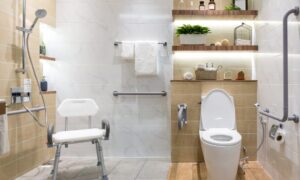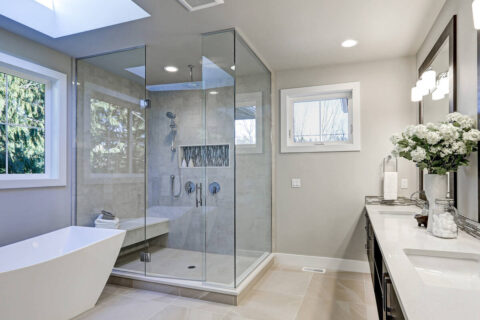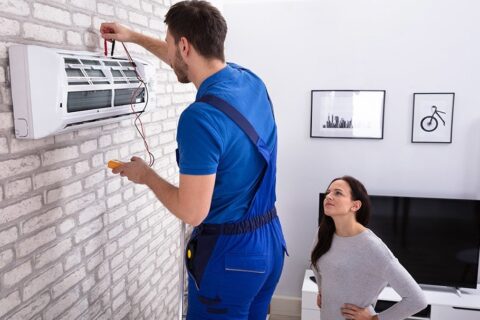Essential Home Modifications for Aging in Place
Aging in place is a top priority for many homeowners. Plumbing upgrades for aging in place can make a significant difference in comfort and safety. Simple changes, like installing grab bars or anti-slip flooring, can enhance mobility and reduce the risk of falls. Modern fixtures can improve accessibility while boosting the overall aesthetic of your home and air.
Smart plumbing solutions and home modification also save money on water bills and reduce maintenance hassles. These upgrades ensure that your home remains functional as you age, allowing you to maintain independence. Investing in these improvements today means a safer, more comfortable living environment tomorrow.
Key Takeaways
-
Consider making exterior modifications like adding ramps and handrails to ensure safe access to your home for aging in place.
-
Reconfigure your floor plan by removing obstacles and creating open spaces to enhance mobility and accessibility.
-
Upgrade entryways and thresholds by installing wider doors and minimal-step entries to make moving in and out easier.
-
Ensure that interior doors and hallways are wide enough for walkers or wheelchairs, allowing for smooth navigation throughout the home.
-
Focus on improving bathroom accessibility by installing grab bars, non-slip surfaces, and walk-in tubs or showers for safety.
-
Explore smart plumbing technologies that can automate tasks and monitor water usage, making your living space more efficient and user-friendly.
Understanding Aging in Place
Definition
Aging in place means living in one’s home as they grow older. It allows seniors to maintain their independence. Many seniors prefer this option of home modification over moving to living facilities. Staying at home can provide comfort and familiarity.
Importance
Independence is crucial for many seniors. It helps preserve dignity and self-esteem. Aging in place supports a sense of control over daily life. This approach can also reduce feelings of isolation. Seniors often feel more connected to their community at home.
Home Modifications
Home modifications play a vital role in aging in place. Adjustments can enhance safety and comfort for seniors. Simple changes like installing grab bars can prevent falls. Wider doorways can accommodate wheelchairs or walkers. These modifications create senior living spaces that meet the needs of aging adults.
Planning Ahead
Planning for future needs is essential for aging homeowners. Anticipating changes can save money later on. Retrofitting a home after an injury can be costly and stressful. Instead, proactive adjustments allow for smoother transitions as needs change.
Benefits
Benefits of aging in place include emotional stability and financial savings. Staying home avoids the high costs associated with residential care. Seniors can also personalize their environment, which boosts morale. Familiar surroundings help seniors feel secure and relaxed.
Alternative Housing Options
e may consider alternative housing options as they age. These could include co-housing or senior communities designed for aging adults. However, many seniors still prefer their own homes, where they have established routines.
Common Aging Challenges
Seniors face various aging challenges, such as mobility issues or health concerns. Addressing these challenges through home modifications is crucial. Creating a safe environment reduces risks and enhances quality of life.
Energy Efficiency
Energy-efficient upgrades can benefit aging homeowners too. Installing better insulation or energy-efficient appliances saves money on bills. These upgrades contribute to a more comfortable living space.
Exterior Modifications for Safety
Ramps Installation
Install ramps to provide easy access for mobility devices. Ramps make it simpler for people using wheelchairs or walkers to enter and exit the home. The Americans with Disabilities Act (ADA) recommends a slope ratio of 1:12 for ramps. This means that for every inch of height, there should be at least 12 inches of ramp length.
Properly constructed ramps can prevent accidents. They should have non-slip surfaces to ensure safety, especially in wet conditions. Adding a railing on both sides offers extra support. Regular maintenance is essential to keep ramps in good condition.
Well-Lit Walkways
Ensure walkways are well-lit and free of obstacles to prevent falls. Poor lighting can lead to accidents, especially during nighttime. Install motion-sensor lights along pathways to enhance visibility. Bright lights help everyone see where they are walking.
Remove any clutter or debris from walkways. This includes leaves, snow, or garden tools that could cause trips and falls. Consider using low-maintenance materials for walkways. Pavers or concrete surfaces are durable and require less upkeep.
Handrails Addition
Add handrails on stairs and porches for additional support. Handrails provide stability when navigating steps or raised areas. They should be installed at a height between 34 and 38 inches, according to building codes. This height is comfortable for most users.
Choose sturdy materials like metal or wood for durability. Ensure handrails are securely fastened to withstand pressure. Regularly check handrails for wear and tear, replacing them as needed.
Garage Accessibility
Modify the garage area for better accessibility. A level entry point is crucial for those with mobility challenges. Installing an automatic garage door opener can simplify access, reducing physical strain.
Consider adding storage solutions that are easy to reach without bending down too much. Shelving units should be adjustable and within arm’s reach to avoid unnecessary stretching.
Balcony Surfaces
Evaluate balcony surfaces for safety features. Slip-resistant coatings can prevent falls on balconies during wet weather. Adding a low wall or barrier around the balcony enhances protection.
Regular inspections of balcony surfaces are vital for maintaining safety standards. Check for any signs of wear, such as cracks or loose boards, and repair them promptly.
Floor Plan Adjustments for Accessibility
Open Floor Plans
Creating an open floor plan can significantly improve accessibility in a home. This design allows for easy navigation, especially for those using mobility aids. It removes barriers that may restrict movement. An open layout connects living areas, kitchens, and dining spaces seamlessly. This connection reduces the need to navigate through narrow hallways or doorways.
Homeowners should consider how furniture placement affects flow. Large pieces can block pathways. Removing unnecessary furniture enhances space for movement. Fewer obstacles lead to safer environments for seniors.
Clear Pathways
Designating clear pathways between rooms is essential. These paths should be wide enough to accommodate walkers or wheelchairs. A minimum width of 36 inches is recommended for safe navigation. Homeowners must ensure these routes are free of clutter.
Minimizing hazards is crucial in senior living accessibility. Avoid rugs or mats that can cause tripping. Install non-slip flooring to enhance safety. Proper lighting also plays a vital role in visibility along these pathways.
Structural Modifications
Consider making structural home modifications to support accessibility needs. Installing grab bars in bathrooms and hallways provides extra support for individuals with physical limitations. Reinforcing walls can help secure these bars effectively.
Height adjustments may also be necessary in areas like kitchens and bathrooms. Lowering countertops can make tasks easier for seniors who may have difficulty reaching standard heights. These modifications contribute to a more functional home design.
Planned Renovations
Planning renovations should focus on long-term needs. Homeowners must think about their current and future requirements as they age. A comprehensive home renovation plan ensures that all aspects of accessibility are covered.
Incorporating features like wider door frames and lever-style door handles can enhance usability. These elements make it easier for seniors to move around without assistance. Investing in the right home modifications now can prevent costly changes later.
Main Level Living
Shifting essential living spaces to the main level is another effective strategy. This adjustment minimizes the need to use stairs, which can be challenging for seniors with mobility issues. Having bedrooms, bathrooms, and laundry facilities on one level increases independence.
This approach also allows for more comfortable living arrangements for caregivers if needed. The focus should always remain on creating a supportive environment that fosters autonomy.

Enhancing Entryways and Thresholds
Wider Doorways
Widening doorways is essential for aging in place. This change allows for easier access with wheelchairs and walkers. Standard door widths are often too narrow. A width of at least 36 inches is recommended. This adjustment can make a significant difference in mobility.
Homeowners should also consider the type of doors used. Sliding doors or bi-fold doors can provide more space. These options help create a smoother transition from one area to another. Wider doorways improve overall accessibility.
Lowered Thresholds
Lowering thresholds is another critical upgrade. High thresholds can pose tripping hazards. They can be challenging to navigate for those with mobility issues. Eliminating them entirely is ideal for seamless transitions between rooms.
For outdoor spaces, this means creating a smooth path from the inside to the outside. Installing ramps can also help in these areas. Ramps should have a gentle slope to ensure safety and ease of use.
Automatic Door Openers
Automatic door openers enhance convenience and accessibility significantly. They allow individuals to enter and exit without needing physical strength. This feature is especially helpful for those with limited mobility.
Installation of these openers is straightforward. Many models are available that fit most door types. They can be activated by remote control or motion sensors. This technology promotes independence for residents.
Improved Lighting
Proper lighting enhances safety around entryways and thresholds. Bright lights reduce the risk of falls during evening hours. Consider installing motion-sensor lights near entrances and stairways.
Outdoor living spaces benefit from well-placed lighting too. Pathway lights guide visitors safely to the entrance. Adequate illumination also improves visibility for doorbells and other features.
Support Features
Adding support features like handrails is beneficial for stairways and ramps. Handrails provide stability when navigating changes in height. They should be installed on both sides of stairways for added safety.
Porch builders can integrate these features into new construction as well. Support can come in various forms, such as decorative railings that match home aesthetics.
Maintenance Considerations
Maintaining shrubs and landscaping around entryways is vital for safety too. Overgrown plants can obstruct pathways and create hazards. Regular trimming ensures clear access to doors and ramps.
Consider using brick or other sturdy materials for outdoor surfaces. These materials withstand weather changes and require less maintenance over time.
Optimizing Interior Doors and Hallways
Door Handles
Lever-style door handles are a smart choice. They are easier to operate than traditional knobs. This is especially important for older adults or those with limited hand strength. Lever handles require less grip and can be pushed down with the forearm if needed.
Choosing these handles improves accessibility throughout the home. Home remodelers recommend installing them on all doors, including bedrooms and bathrooms. This small change can make a significant difference in daily life.
Hallway Width
Hallways should be at least 36 inches wide. This width allows for safe passage, especially for those using walkers or wheelchairs. Narrow hallways can pose risks of accidents and hinder mobility.
Home renovation professionals often assess hallway dimensions during planning. They know how critical space is for safety and ease of movement. Wider hallways also provide a more open feel in the home.
Sliding Doors
Sliding doors are an excellent option for saving space. They do not swing open like traditional doors, which helps maximize room usage. Installing sliding doors can enhance accessibility in tight areas, such as bedrooms and bathrooms.
These doors work well in hallways too. By using sliding doors, homeowners can create more usable space while maintaining ease of access. This feature is crucial when considering aging in place.
Flooring Choices
Flooring plays a vital role in optimizing interiors. Choosing smooth surfaces like vinyl or wood can reduce trip hazards. Avoid thick carpets that might obstruct movement or create difficulties for those with mobility aids.
Vinyl flooring offers durability and easy maintenance. It comes in various designs, allowing homeowners to match their decor while ensuring safety. Wood floors provide warmth but need to be carefully selected to avoid slippery finishes.
Shelving Solutions
Adjustable shelving can help optimize storage in bedrooms and other rooms. This flexibility allows homeowners to customize heights based on their needs. Ensuring items are within reach reduces the risk of falls.
Home renovation professionals suggest using lower shelves for frequently used items. Keeping things organized makes it easier for everyone, especially seniors who may struggle to bend or reach high places.
Improving Bathroom Accessibility
Strategic Grab Bars
Install grab bars in strategic locations around the bathroom. These bars provide essential support for individuals with mobility challenges. Place them near the toilet, shower, and bathtub. They should be sturdy and can hold significant weight. The installation of grab bars is a permanent home improvement that enhances safety.
Consider using different types of grab bars. Horizontal bars work well for transfers, while vertical ones assist when standing up. Ensure they are placed at a height that is comfortable for the user. This simple modification can make a big difference in daily routines.
Accessible Showers
Showers must be designed for easy access. A curbless shower allows individuals to enter without stepping over a barrier. This design reduces the risk of falls. It is especially important for those using wheelchairs or walkers.
Incorporate a fold-down seat in the shower area. This feature provides a safe place to sit while bathing. It also allows caregivers to assist without straining their backs. The combination of these elements creates an accessible and safe bathing experience.
Slip-Resistant Flooring
Choose slip-resistant flooring for bathrooms. This type of flooring helps reduce the risk of slips and falls, which are common accidents in wet areas. Materials like textured vinyl or rubber are good options. They provide traction even when wet.
Proper flooring choices contribute significantly to overall safety. Consider installing rugs with non-slip backing outside the shower or tub. This adds another layer of protection against falls.
Adequate Handrails
Handrails are essential in bathrooms, especially near steps or elevated areas. Install handrails beside toilets and in hallways leading to the bathroom. These features help users maintain balance and stability.
Ensure the handrails are securely anchored to walls or floors. They should be easy to grip and positioned at a convenient height. Effective home modifications like these make navigating the bathroom safer.
Functional Toilets
Toilets must also be considered in bathroom renovations. Higher toilets can ease the process of sitting down and standing up. Look for models designed specifically for accessibility.
Consider adding toilet risers if replacing the toilet isn’t feasible. These devices elevate the seat height without requiring a full renovation project. They offer immediate assistance for those with limited mobility.
Kitchen and Appliance Adjustments
Appliance Heights
Positioning appliances at accessible heights is crucial. Lowering ovens and microwaves reduces the need to bend or stretch. This simple adjustment makes cooking safer and easier for everyone, especially older adults.
Refrigerators should also be at a comfortable height. This allows users to reach items without straining. Consider side-by-side models or French door styles for better access.
Storage Solutions
Incorporating pull-out shelves and drawers can transform kitchen storage. These features allow easy access to pots, pans, and other items. They eliminate the need to dig through deep cabinets.
Removable base cabinets are another great option. They provide extra space for mobility aids like walkers or wheelchairs. This flexibility ensures that kitchens remain functional as needs change.
Touchless Faucets
Using touchless faucets simplifies daily tasks. These faucets allow users to turn on water with a wave of their hand. This feature is especially helpful when hands are messy or full.
Touchless technology can also conserve water. It automatically turns off when not in use. This helps reduce water bills while promoting sustainability.
Counter Space
Adequate counter space is essential for safe meal preparation. Expanding counters can provide room for food prep and cooking appliances. Consider adding an island with additional seating for socializing while cooking.
Adjustable countertops can also cater to different heights. This feature accommodates both standing and seated users. It promotes comfort during meal preparation and clean-up.
Lighting Improvements
Proper lighting enhances safety in the kitchen. Install light switches at reachable heights for easy access. Consider motion sensor lights for hands-free operation.
Under-cabinet lighting can brighten work areas. This ensures that chopping vegetables or reading recipes is easier and safer.
Heating and Cooling
Air conditioning and heating systems should be user-friendly. Programmable thermostats allow users to adjust temperatures easily. This feature ensures comfort throughout the year.
Consider installing ceiling fans for better air circulation in warmer months. They help reduce reliance on air conditioning, which can lower energy costs.
Smart Plumbing Technologies
Leak Detectors
Implementing smart leak detectors is a vital step for any home. These devices alert homeowners to leaks before they become major problems. They connect to your home’s Wi-Fi and send notifications to your phone. This way, you can act quickly to prevent water damage.
Older homes often face plumbing issues due to wear and tear. Smart leak detectors help you avoid costly repairs. They can be placed near sinks, toilets, or water heaters. Early detection makes a big difference in maintenance costs.
Water Heaters
Utilizing smart water heaters offers several benefits. These appliances allow for efficient temperature control. You can adjust the settings remotely using an app. This feature helps save energy and money on utility bills.
Older models may not have the same efficiency as newer ones. Smart water heaters provide real-time data on usage patterns. This information helps you make informed decisions about hot water needs. Investing in a smart water heater is a practical choice for aging in place.
Voice-Activated Fixtures
Considering voice-activated plumbing fixtures adds convenience to daily tasks. These fixtures allow hands-free operation, which is essential for those with mobility issues. Simple commands can turn on faucets or flush toilets without needing physical contact.
This technology enhances safety in the kitchen and bathroom. It reduces the risk of slips and falls while reaching for handles. Voice-activated fixtures integrate easily with smart home systems. They can also connect with other devices like thermostats and smoke alarms for added security.
Future Planning
Smart plumbing technologies are not just trends; they are essential for future living spaces. As homes age, these upgrades provide better functionality and safety. They adapt to the changing needs of residents over time.
Investing in these technologies now prepares your home for the future. You can enjoy peace of mind knowing that your plumbing system supports your lifestyle as you age.
Steps to Implement
-
Assess your current plumbing system.
-
Identify areas that need upgrades.
-
Research available smart technologies.
-
Choose devices that fit your budget.
-
Schedule installation with professionals.
Closing Thoughts
Embracing plumbing upgrades for aging in place is crucial for ensuring comfort and safety. You’ve explored various modifications, from enhancing entryways to optimizing bathroom accessibility. These changes empower you to create a home that supports independence and well-being.
Investing in smart plumbing technologies can further elevate your living experience. Take action now—assess your space and prioritize upgrades that fit your needs. Consult with professionals to implement these solutions effectively. Your home should be a sanctuary, ready to adapt as life evolves. Make it happen!
Frequently Asked Questions
What is aging in place?
Aging in place refers to the ability of seniors to live independently in their own homes as they age. It involves making necessary modifications to ensure safety, comfort, and accessibility.
Why are plumbing upgrades important for aging in place?
Plumbing upgrades enhance safety and accessibility. They prevent accidents and make daily tasks easier, allowing seniors to maintain independence while ensuring a comfortable living environment.
What exterior modifications should I consider?
Consider installing ramps, handrails, and improved outdoor lighting. These changes enhance safety and ease of access, making it easier for seniors to navigate their surroundings.
How can I improve bathroom accessibility?
Install grab bars, non-slip flooring, and a walk-in shower. These features provide support and reduce the risk of falls, ensuring a safer bathing experience for seniors.
What kitchen adjustments are beneficial for seniors?
Lower countertops, pull-out shelves, and easy-to-reach appliances can significantly improve kitchen functionality. These adjustments make meal preparation safer and more convenient for seniors.
Are there smart plumbing technologies available?
Yes, smart plumbing technologies like leak detectors, automatic shut-off valves, and smart faucets enhance safety. They provide alerts for potential issues, helping prevent costly damage and ensuring peace of mind.
How can I optimize interior doors and hallways?
Widen doorways and install lever-style handles for easier access. Clear hallways of obstacles to create a safe path. These adjustments improve mobility and reduce the risk of accidents.


